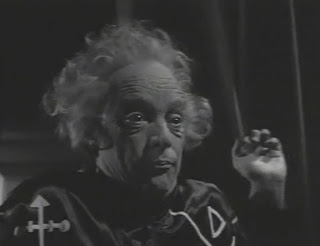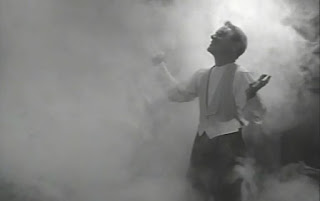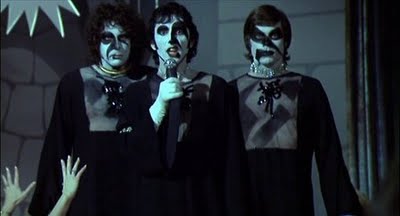The spider web fills the screen, it's Boris Karloff's THRILLER!
Season: 1, Episode: 35.
Airdate: May 30, 1961
Director: John Brahm.
Writer: John Tomerlin.
Cast: Harry Townes, Ilka Windish, Henry Silva, Ned Glass.
Music: Jerry Goldsmith.
Cinematography: John Warren.
Producer: William Frye.
Boris Karloff’s Introduction: “A gloomy place, a library; filled with forgotten knowledge, undisturbed passion, suspended lives and deaths, sufferings and ecstacy. Many histories are written in all of these books, including an interesting record of the man who opened them. For what could we not discover ig we but knew what ones had amused, interested, or obsessed him? Suppose the owner of all these, a dying man, should choose just one book as his gift to the living? What sort of a book would it be? Well, that of course would depend upon the man himself. If he’s a very good man he might leave a very good book. A very evil man? Well his gift might be called a dark legacy. Our players tonight are: Harry Townes, Ilka Windish, Richard Hale, Doris Lloyd, and Henry Silva as Toby Wolfe. Each of these distinguished persons is fated to find out it isn’t the gift that counts... it’s the spirit behind it.”
Synopsis: The fog breaks and we see a massive country estate in the darkness. Inside, three people sit on opposite sides of the huge great room waiting... as an ancient Butler (Milton Parsons) comes down the stairway carrying a silver platter. He tells the three that the Master Of The House has asked them to write their names on the pieces of parchment on the platter to aid him in his decision for inheritance. Each signs the parchment with an ancient quill pen: monocled Cousin Lars Eisenhart (Richard Hale), elderly Cousin Edith Pringle (Doris Lloyd), and mid 30s Nephew Mario Asparos (Harry Townes) each sign and then return to their corners of the great room. They are distant relatives in competition for the inheritance. This is a family of Illusionists, and each of the three makes a living doing magic shows in night clubs around the world... and the inheritance is the old Master’s amazing magic act. How did he do those tricks? The Butler carries the silver platter upstairs and we follow him into the Master’s bedroom...
Which is filled with occult materials. The ancient Master, Radan Asparos (also Harry Townes completely unrecognizable) takes the three pieces of parchment and places them in a huge book, then casts a spell asking the Prince Of Darkness to choose his successor in cursed sorcery. Hey, the three relatives downstairs think they’re getting *money*! Or maybe the secrets of magic *tricks*! Smoke and flames and lightening and wind and two pieces of parchment burn while one flutters in the wind and returns to the huge book: Nephew Mario’s will inherit. Old Radan then climbs into his coffin, closes the lid, and dies!
In the city, at the crappy Nocturne Club, Mario Asparos is headlining as a Illusionist... and failing. The Club Owner Vince (Ned Glass) tells him he’s fired by the end of the week if he doesn’t come up with a new routine that fills the house. His assistant & wife Monika (Ilka Windish) is worried... the pay sucks here, but they can’t live without the money. In the dressing room is old friend Toby Wolfe (Henry Silva) an Illusionist turned “medical hypnotist” just back from Europe. Mario gets a phone call: they are reading Uncle Radan’s will tonight, he needs to get to the mansion. Toby offers to drive him.
At the mansion, Cousin Lars and Cousin Edith are waiting. Lars is a slight of hand Illusionist as well, and is doing coin tricks while he waits. Cousin Lars knows Toby... and wonders why the lawyer is late. Probably caught in the storm. The lawyer Pinchot (BATMAN’s Alan Napier) arrives and reads the will... boring money division stuff, and finally what they have all been waiting for: the secrets of his magic act. But that isn’t part of the will. The magic act seems to have died with the old man. His library has been willed to a university, except for one book... and the recipient will know who they are when they receive it. The phone rings on this dark and stormy night, call for Mario from his wife.
Monika is frightened. The storm has knocked out the lights in their house and the windows keep blowing open... and then this ancient book popped up on the desk. Maybe someone broke in and put it there? She wants Mario to return immediately.
Mario returns home and checks the doors and windows: all locked. No way someone could have broken in. The lights are back on, now, and it seems less frightening but Monika is still freaked. Where did the book come from? Hey, the old man was a Master Magician, this was just some kind of trick. Maybe there’s more about the trick in the book? Mario and Toby look at the book... and there are no magic tricks! Just some mumbo jumbo about spells and stuff. Toby heads home.
Monika thinks they may be able to sell the book and make a couple of bucks. They have an argument, Monika never liked Uncle Radan. He may have been the world’s greatest Illusionist, but he freaked her out... and the book freaks out their dog (who won’t come into the room when the book is there). Monika goes to bed and Mario continues to thumb through the old book... thinking it might be fun to try a spell. It’s all just nonsense, right?
Smoke comes out of the fireplace and washes over the dog... who falls over dead! Mario incants, “Princes of darkness, I welcome you!”
THREE WEEKS LATER: His magic act is held over at the Nocturne Club and *sold out*! The grand finale of the act: Monika stands on the other side of a pane of glass and Mario fires a gun through the glass and Monika catches the bullet in her teeth! Then he passes the bullet through the audience so they can see that it’s real.
After the performance Club Owner Vince (Ned Glass) wants to renew their contract but Mario refuses... they’re opening in Vegas next week. Mario has become full of himself and kind of a dick. Monika calls Toby, she’s worried. Toby stops by the club, and Mario becomes jealous (Monika used to be Toby’s assistant)... Toby thinks Mario’s new tricks are the result of finding a code that turned that silly spell book into the source of all of old Radan’s magic tricks. Toby is fascinated by the magic bullet trick, and wants to know what Radan’s secret trick was, because this is a *dangerous* trick and there are magicians who have gone through several assistants and still never pulled it off. The trick is done with mirrors and cotton batting and a bullet hidden in the assistant’s mouth, but even with a light load the bullet fired from the gun can accidentally kill the assistant. Mario tells Toby it isn’t a trick: Monika catches the real bullet in her teeth. “It isn’t a trick! Nothing I do anymore is a trick!” Mario didn’t find some code for the old book, he found the real secret of Radan’s powers... the mystery of the ages! Toby doesn’t believe in magic: it’s all tricks to him, and even this is a trick. Mario has tricked himself into believing that the book contains magical spells, but it’s just mumbo jumbo. Toby thinks Mario has been lucky so far, but someday he’s going to kill Monika. Mario says he can prove that it’s magic...
At the house, Mario is going to put on an exhibition for Monika and Toby. Mario has remodeled his study into a sorcery room (he’s obviously lost his mind) and puts on a wizard’s robes, preparing to call out the demon who grants him power. Once again, he accuses Toby and Monika of having an affair. They think he’s paranoid. He does his incantations and the smoke comes from the fire place and the demon Astroth appears! Toby yells from Mario to destroy the book, but Mario tells Astroth to take Toby and Monika. Toby grabs the book and throws it into the fireplace. The book bursts into flames. The demon comes after Mario...
When the smoke clears, Mario is dead on the floor...
Toby wonders if there was a demon in the first place? What if it was a form of hypnosis? What if Mario’s belief made Toby and Monika believe they saw the demon? It was never magic, just a trick?
Was it?
Review: Horror stories probably have their roots in Fairy Tales. I know that seems like a crazy statement, but Fairy Tales were usually magical stories with a point, often a cautionary tale... and that’s a subgenre of horror as well: The Cautionary Tale. This is one of them. All of these relatives wish they had the secret to the old man’s magic, but they should be careful what they wish for! The old man was an Illusionist who took a walk on the dark side and became a sorcerer... and the World’s Greatest Magician. Now his relatives want to know those secrets... or do they? Though this story is spooky and deals with demons, there are no real scares here... more a cautionary tale where a man trades his financial descent for a moral descent.
I think it’s interesting that the story focuses on the differences between “Illusions” and “Magic”... the difference between tricks and spells. From the audience’s point of view it may all seem the same, from the performers point of view one is a carefully practiced skill and the other is the work of demons or spirits or things from another world.
Harry Townes was one of those working actors you’ve seen on a million TV shows, usually playing doctors or lawyers or professors. When I looked him up on IMDB I expected him to be British or maybe Canadian ... but he was born and died in Alabama. Probably in that last generation of classically trained actors before Method came into vogue. And his work here is amazing, I did not know he played old Radan until the closing credits. He moves like an old man, and has that old person mouth thing going. All of his mannerisms are old, and his hands tremble convincingly. This is a journeyman actor, not a star, just the guy who usually plays that educated person role who may be in a scene or two... and he gives a brilliant performance both as the old man and as his young nephew. But his IMDB lists Westerns and Good Old Boys and just about every kind of character role imaginable. Somewhere, we lost most of the actors like this. Now instead of an actor who can play *any* character, we have actors who can only play *one* character, and when they need a guy to play the Good Old Boy they hire the guy who always plays that role. No actual acting required!
Henry Silva was probably a “get” for this episode, he’s done a bunch of Westerns and the original OCEAN’S ELEVEN just before this... and would really break through the next year in MANCHURIAN CANDIDATE. Because of his skull like face which probably landed him all of those villain roles, it’s easy to forget that he’s also a great *actor*, and here he’s often stuck with exposition and manages to make it feel like natural conversation.
The special effects are amazing for a TV episode. I’m still trying to figure out how they did the slip of paper going from the fireplace to zipping back to the spell book and sliding between the pages. I suspect this was shot in reverse and in slow motion with the slip of paper between the pages of the book and then blown by a directional fan out of the book towards the fireplace. Shooting in reverse is a great old school FX trick! My friend Paul Kyriazi has a scene in a film where a man falls into the street and a car hits the brakes, front wheel coming to a stop *as it touches the man’s head*! It was just shot in reverse, with the car backing away from the man’s head, then they added the sound effect of skidding tires.
There is a great rack focus shot here where we see the bullet hole in the glass and then change focus *through the glass* to Monika snapping her head up with the bullet in her teeth. It appears as if we have actually *seen* her catch the bullet in her teeth, but it's just another no budget special effect with the rack focus making us think we are seeing the bullet.
The appearance of Astroth is also pretty good considering the budget and schedule. The room is filled with smoke and then a pair of eyes are superimposed over the smoke so that it appears as if the smoke itself grows eyes. For a cheap effect, it’s pretty scary. I’m sure they put some effort into casting the eyes.
This story also links bad weather to the supernatural, with thunder and lightning coming on cue. When Mario gestures, thunder and lightning answers. Talk about a cheap effect! But it completely works! He is *summoning* thunder and lightning! These are the kinds of effects you can still do for $1.98 in a low budget film, but few seem to take advantage of them.
Last but totally not least: another amazing Jerry Goldsmith score! He was working on THRILLER and TWILIGHT ZONE simultaneously at this time, and the next year would be his film break out with LONELY ARE THE BRAVE. His score here sets a spooky tone and really adds to every single scene. I wish all of these TV scores were available, because these great composers were at the top of their games and cranking out a new score every week (or maybe twice a week if they were working on two shows). This was a golden age for TV music.
Next week, Stephen King’s favorite episode... and what he believes is one of the most frightening hours of television ever made!
Bill
Speaking of old libraries with rare books with potentially spooky pasts, Fangoria Magazine’s British correspondent Philip Nutman passed away a year and a half ago, and his extensive library of horror books, film books, autographed comic books, and many other curios has just been placed on sale (yesterday!). Since this week’s THRILLER episode was about the terrors which might be found in the library of a book collector who has passed away, I thought some of you might be interested in these rare books and collectables from Philip Nutman’s Estate, being sold through Burnt Biscuit Books:
* The Philip Nutman Collection On Ebay.
* The Philip Nutman Collection At Amazon.


























